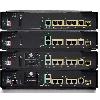Major Enhancements for Access Accelerometer and Gyro Sensor Data
Access Accelerometer and Gyro Sensor Data from IRM-GNSS
This feature allows accelerometer and gyro sensor data from IRM-GNSS (GPS DR) module to be streamed to the IOX via a TTY in IR1800. Prior to this release, the IRM-GNSS module pushed the sensor data to the host in NMEA via port /dev/ttyS2. Previous IOS XE releases already parsed and cached the data.
The feature will forward the sensor data to IOX via the TTY whenever the data is received from the NMEA. Currently, there is no control on the frequency the data is sent from the module, which totally relies on the module itself.
There are no new commands for this feature. It is enabled by default once dead reckoning is enabled. Existing CLIs can be used to view the sensor data, for example:
Router# show platform hardware gps dead-reckoning
DR Vehicle interface mode: OBDDIIGPS/DR Vendor Info: TELITGPS/DR module FW Version: V33-1.0.5-CLDR-4.7.10-N115R115-003291-3…Raw Accel Data in X: -542Raw Accel Data in Y: 538Raw Accel Data in Z: 16964Raw Gyro Data in X: 153Raw Gyro Data in Y: -80Raw Gyro Data in Z: 99
The existing debug platform hardware gps dead-reckoning command has been enhanced to provide additional debug messages for better serviceability. The debug messages will cover the following:
- How frequent the sensor data are pushed from the module to IOS, it must at least once per second.
- The latest sensor data received from the module.
5G Standalone Mode (SA) Support
This feature provides 5G Standalone mode (SA) support on the P-5GS6-GL pluggable module. The 5G SA mode support will enable 5G cellular configuration display using Cisco IOS-XE CLI commands.
This feature provides a mechanism in the CLI to select a set of bands for SA mode, as opposed to a single band in previous software releases. The following IOS-XE CLIs have been modified for 5G SA mode support:
- show cellular radio
- show cellular radio details (without carrier aggregation)
- show cellular network
There is also a band selection CLI to select cellular bands.
Show Command Examples
Router#show cellular 0/2/0 radioRadio power mode = Online5G Rx Channel Number = 6325445G Tx Channel Number = 6325445G-SA Band = 78Bandwidth = 20 MHzCurrent 5G RSSI = -60 dBmCurrent 5G RSRP = -71 dBmCurrent 5G RSRQ = -11 dBCurrent 5G SNR = 34.5 dBPhysical Cell Id = 500Radio Access Technology(RAT) Preference = AUTORadio Access Technology(RAT) Selected = 5GNR-SA
Router#show cellular 0/4/0 radio detailModem Radio is OnlineMain 0 Antenna details:RSSI = -38 dBmRSRP = -48 dBmDiversity 0 Antenna details:RSSI = -47 dBmRSRP = -58 dBm
Router#show cellular 0/4/0 networkCurrent System Time = Sun Jan 6 0:4:36 1980Current Service Status = NormalCurrent Service = Packet switchedCurrent Roaming Status = HomeNetwork Selection Mode = AutomaticNetwork = Test PLMN 1-1Mobile Country Code (MCC) = 1Mobile Network Code (MNC) = 1Packet switch domain(PS) state = AttachedTracking Area Code (TAC) = 1Cell ID = 1024Negotiated network MTU = 1500
Band Selection Command Example
The lte modem band-select CLI can be used to enable bands that the user wishes to use and subscribe to. By default SA bands are not available.
The following is an example of the command:**conf tcontroller cellular 0/2/0lte modem band-select indices umts3g all lte4g all nr5g-NSA all nr5g-SA 78 slot 0exit**
The following shows an example of using nr5g-sa band 48:lte modem band-select indices umts3g "23" lte4g "7" nr5g-nsa "12" nr5g-sa "48" slot 0
The following shows an example of using nr5g-sa band 78:lte modem band-select indices umts3g "23" lte4g "7" nr5g-nsa "78" nr5g-sa "none" slot 0


